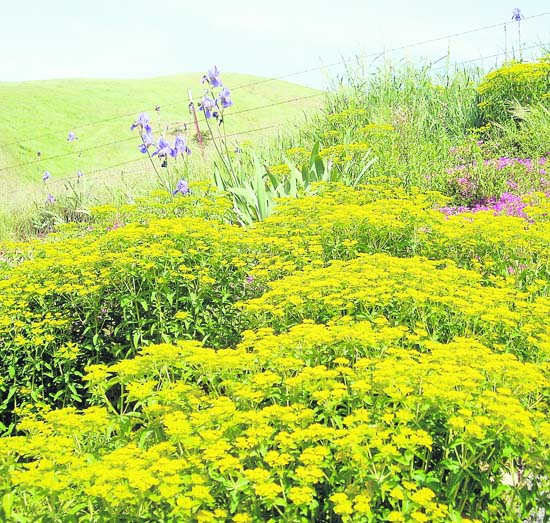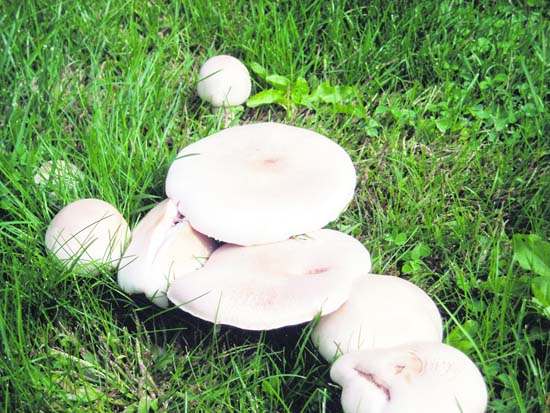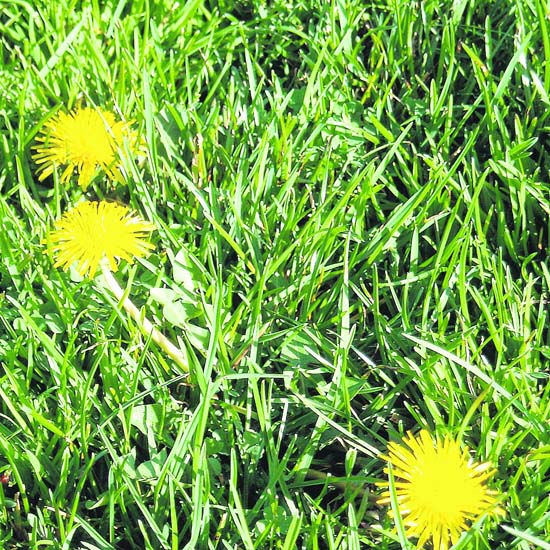| | Published April 29th, 2009
| Digging Deep-Gardening with Cynthia - Please Eat the Dandelions!
| | By Cynthia Brian |  | | Photos Cynthia Brian
|
According to the spring survey completed this week from TechnoMetrica Market Intelligence, consumers report that planting a vegetable garden this year is a number one priority. Since 2003, the traditional leader for dollars spent on gardening items has been for lawns and grasses. Not this year! In spite of, or perhaps because of the current economic issues in the nation, three out of four consumers (74%) say better quality, taste and nutrition are the main reasons they expect vegetable and fruit plants will get their gardening dollars this spring. With an emphasis in our country on improving our health and our eating habits, it only makes sense to dig deep and eat from nature.
 Have you ever contemplated the free, nutritious dinners that await you in your yard right now? At the bequest of program director, Mardi Potts, on April 17th, it was my pleasure to speak to the over two hundred members of the Moraga Garden Club at their annual salad luncheon. My topic was edible weeds and plants. My goal was to assist the attendees in identifying edible, toxic, or poisonous plants. Although I am not a botanist, biologist, or scientist, I learned about edible plants growing up on the farm in Napa Valley where my most of my time was spent in the dirt. It's one of the reasons I named this column, Digging Deep, because I have the belief that all the important lessons for living can be learned in the garden. As the soils warm and you begin to plan your vegetable gardens, why not also take the time to discover delicious, nutritious, and no cost organic culinary treats that are already growing in your backyard?
Have you ever contemplated the free, nutritious dinners that await you in your yard right now? At the bequest of program director, Mardi Potts, on April 17th, it was my pleasure to speak to the over two hundred members of the Moraga Garden Club at their annual salad luncheon. My topic was edible weeds and plants. My goal was to assist the attendees in identifying edible, toxic, or poisonous plants. Although I am not a botanist, biologist, or scientist, I learned about edible plants growing up on the farm in Napa Valley where my most of my time was spent in the dirt. It's one of the reasons I named this column, Digging Deep, because I have the belief that all the important lessons for living can be learned in the garden. As the soils warm and you begin to plan your vegetable gardens, why not also take the time to discover delicious, nutritious, and no cost organic culinary treats that are already growing in your backyard?
 I read once that a weed is simply a plant that wants to grow where people want something else. In blaming nature, people mistake the culprit. Weeds are people's ideas, not natures. Like most gardeners, even though I know a weed is just a flower growing where it's not wanted, I really don't like weeds of any kind in my garden. I am always out pulling and eradicating. Every garden has weeds and many deserve to be recognized for their nutritional value. If I have to pull them out anyway, I might as well eat them. My daughter, who is a vegetarian, has always been game to try my newest culinary creations, while my husband and son are a bit more suspicious.
I read once that a weed is simply a plant that wants to grow where people want something else. In blaming nature, people mistake the culprit. Weeds are people's ideas, not natures. Like most gardeners, even though I know a weed is just a flower growing where it's not wanted, I really don't like weeds of any kind in my garden. I am always out pulling and eradicating. Every garden has weeds and many deserve to be recognized for their nutritional value. If I have to pull them out anyway, I might as well eat them. My daughter, who is a vegetarian, has always been game to try my newest culinary creations, while my husband and son are a bit more suspicious.
 For thousands of years our ancestors feasted on many of the flowers, leaves, and roots that grow in our landscaped gardens. Cooking and garnishing with flowers was popular during the Roman Empire and has played a big role in Chinese, Middle Eastern, and Indian cultures throughout history. During Queen Victoria's reign, edible flowers were all the rage. Little by little, we are seeing the resurgence of restaurants featuring floral edibles and of course, courageous cooks are using them more in the home environment.
For thousands of years our ancestors feasted on many of the flowers, leaves, and roots that grow in our landscaped gardens. Cooking and garnishing with flowers was popular during the Roman Empire and has played a big role in Chinese, Middle Eastern, and Indian cultures throughout history. During Queen Victoria's reign, edible flowers were all the rage. Little by little, we are seeing the resurgence of restaurants featuring floral edibles and of course, courageous cooks are using them more in the home environment.
 Before you eat any plant, there are a few basic guidelines that need to be abided as a health precaution.
Before you eat any plant, there are a few basic guidelines that need to be abided as a health precaution.
 1. Identify with certainty the plant you wish to eat. Before consuming, double check with a reference book. It is not uncommon for only parts of the plant to be edible and other parts to be very poisonous. A good example is wisteria. The flowers are edible, yet the leaves and stems are toxic. Or elderberry-again the flowers are good for teas, the cooked berries are good for jams, but the leaves and stems are highly poisonous.
1. Identify with certainty the plant you wish to eat. Before consuming, double check with a reference book. It is not uncommon for only parts of the plant to be edible and other parts to be very poisonous. A good example is wisteria. The flowers are edible, yet the leaves and stems are toxic. Or elderberry-again the flowers are good for teas, the cooked berries are good for jams, but the leaves and stems are highly poisonous.
 2. Do not pick plants that have been treated with pesticides or insecticides.
2. Do not pick plants that have been treated with pesticides or insecticides.
 3. Never pick flowers from the side of the road because of gas fumes, hazardous waste areas, or garbage dumps.
3. Never pick flowers from the side of the road because of gas fumes, hazardous waste areas, or garbage dumps.
 4. Always wash all plants thoroughly before eating.
4. Always wash all plants thoroughly before eating.
 5. Remove stamens and pistols from blossoms, only eating the florets
5. Remove stamens and pistols from blossoms, only eating the florets
 6. Pick plants in the morning when their water content is highest
6. Pick plants in the morning when their water content is highest
 7. Introduce only small amounts into your diet at a time to make sure you are not allergic. Never consume too many at a time.
7. Introduce only small amounts into your diet at a time to make sure you are not allergic. Never consume too many at a time.
 Edible Plants
Edible Plants
 Some of my favorite edible weeds are Miner's lettuce, dandelions, mustards, plantain, chicory, chickweed, Lambs quarters, watercress, and purslane. Although I grew up foraging for mushrooms, I no longer advocate this adventure because of the dangers of misidentification. It's better to be safe than sorry.
Some of my favorite edible weeds are Miner's lettuce, dandelions, mustards, plantain, chicory, chickweed, Lambs quarters, watercress, and purslane. Although I grew up foraging for mushrooms, I no longer advocate this adventure because of the dangers of misidentification. It's better to be safe than sorry.
 Most of these common weeds are delicious in salads or cooked as a vegetable. Chicory and dandelion roots are used as a coffee substitute or additive while dandelion flowers may be made into tasty wine or jelly. Dandelion is also a diuretic. When I lived in France, we ate lots of dandelions, both leaves and flowers, as a salad. Their nickname was "pissenlits" which literally means, "wet your bed." The leaves and flowers of the mustard plant are wonderful raw or cooked with a rather peppery flavor.
Most of these common weeds are delicious in salads or cooked as a vegetable. Chicory and dandelion roots are used as a coffee substitute or additive while dandelion flowers may be made into tasty wine or jelly. Dandelion is also a diuretic. When I lived in France, we ate lots of dandelions, both leaves and flowers, as a salad. Their nickname was "pissenlits" which literally means, "wet your bed." The leaves and flowers of the mustard plant are wonderful raw or cooked with a rather peppery flavor.
Lamb‚Äôs quarters young leaves are most flavorful when saut²©ed with olive oil and garlic. Of course, everything tastes great with garlic added to the dish. My favorite recipe with watercress is to use it in place of spinach in a salad with chopped egg, a little bacon, and splashed with a red wine vinaigrette. Remove the fibrous veins and midribs on the new leaves of plantain to eat in a salad. Part of the portulaca species, purslane tastes like spinach and it boasts five times the concentration of Omega 3 fatty acid. It is also very high in vitamin C. A little of each weed goes a long way. Consider adding just a few sprigs to your table while you experiment with these wild edibles.
Many plants growing in your garden are both decorative and delightful in your cuisine. Blossoms from most herbs and fruit trees are edible including apple, banana, basil, chives, citrus, pea, pear, pineapple guava, pumpkin, radish, rosemary, sage, squash, sunflower, and thyme. Here’s a list of popular plants that you may enjoy. Again, before you eat any plant, make sure to follow the seven guidelines I’ve provided as different people may have different tolerances. 
|
Begonia, tuberous hybrids
Calendula
Carnations
Dianthus
Chamomile
Chervil
Chrysanthemums
Clover
Cornflower
Day Lilies |
Daisy (English and Shasta)
Fuchsia
Sorrel
Gladiolus
Hibiscus
Honeysuckle flowers
Jasmine
Johnny Jump Ups
Lilac
Mints
|
Nasturtiums
Pansy
Peony
Primrose
Roses
Scented Geranium
Snap Dragon
Sunflower
Tulips
Violets |
This year as you prepare to plant your kitchen garden, take stock of what is already growing in your backyard. Learn to identify your plants and weeds, then, enjoy your free buffet.
“May all your weeds be wildflowers, or at least dinner!” Cynthia Brian |
 | | Cynthia Brian (left) and Mardi Potts Photo provided
|  |  |
Cynthia’s Digging Deep Gardening Guide for May
This month, it is truly springtime in our gardens. Breathe deeply of the perfumed air, appreciate the blossoming cherries, marvel at the buds bursting with magnificent colors, and enjoy living in such a richly natural environment. Make sure to don an old pair of socks and dance in the wildflowers on a bright sunny day. Playtime begins in the garden this month.
• PREPARE your soil for planting by enriching it with the compost from your Biostack bin.
• RAKE all leaves and add to your compost pile or Biostack bin.
• CHECK temperature of soil before planting your vegetables. To root properly, vegetable seedlings
need the warmer weather.
• PATROL for gophers, voles, and moles. Consider burying wire mesh while planting. Beware!
These invaders love rose roots.
• PLANT summer annuals such as cockscomb, cosmos, dahlias, petunias, phlox,
sweet alyssum, and marigolds.
• BUY your plants in six packs for better root development. The bigger the pot,
the more difficult to thrive.
• SOW melons and pumpkins from seed or seedlings. Plant vegetables in raised beds for
easier tending.
• GROW tomatoes in containers to harvest them nearer the kitchen.
• MOW lawns weekly and scatter another dose of nitrogen-rich fertilizer.
• USE organic products for the healthiest grass, flowers, and you.
• FEED annuals, fruit trees, roses, and any plant that may be yellowing.
• WEED while the weeds are still small. Determine which are edible and which to add to
the compost bin.
• PRUNE hedges, evergreens, flowering shrubs, vines (like wisteria), and rhododendrons
after flowering.
• SHEAR the suckers growing on trees and roses to keep your specimens healthy.
• PINCH flower buds to encourage a thicker and more bountiful blooming period.
• DEADHEAD roses as blooms are spent to encourage rapid re-budding.
• REMOVE old foliage around the new growth of perennials. Keep mulch several inches away
from the stems. This will help prevent disease or rotting.
• REMEMBER to let tulip and daffodil foliage yellow and die before cutting back so sufficient
nourishment resets the embryonic bulb for bloom next year. Do not tie with rubber bands.
• RAKE the remaining fallen camellia blossoms and to the compost bin.
• MULCH around your trees and plants to keep in moisture and deter weeds.
• PICNIC in the beautiful green hillsides carpeted with California poppies and lupines before the
weather gets too hot.
• REMEMBER mom on Mother’s Day by giving her a perennial!
Happy gardening to you! Dig deep!
| | | | Advertisement | | |
| | | | | | Comments | | | | | | | | | | | | | | | Subscribe / Unsubscribe | | | | | |
| | | | | |  | | |
| | |  | | |
| | | | | |
Happy Gardening to You!
©2009 Cynthia Brian,
The Goddess Gardener
Cynthia Brian’s new book,
Be the Star You Are! for Teens debuts in September.
Several chapters were contributed by local teens. Pre-orders are available now. Cynthia is available as a lecturer, writer, and coach.
Call 925-377-STAR or email, Cynthia@star-style
| |

